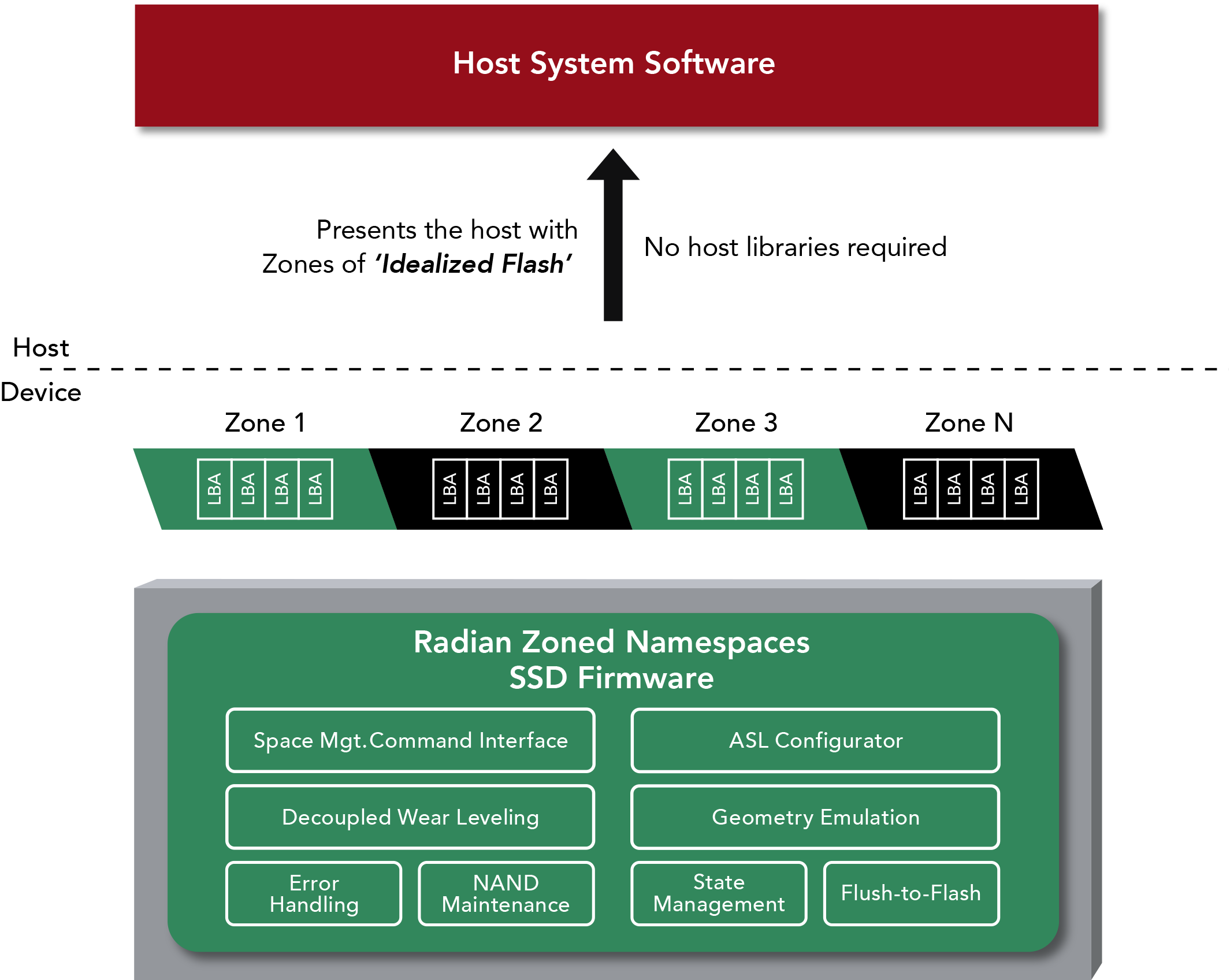 Compliant with the Zoned Namespaces (ZNS) specification from the NVM Express™ industry standards organization, Radian’s Zoned Namespaces are idealized, configurable Flash SSD zones and the implementation won the 2019 Flash Memory Summit award for ‘Most Innovative Technology’ in the category of SSD firmware. Radian introduced the industry to the concept of Zoned Flash SSDs in 2015 with a presentation at the SNIA annual Storage Developer’s Conference (SDC), and shipped first evaluation units of its Zoned Flash drives to OEM customers in January 2018.
Compliant with the Zoned Namespaces (ZNS) specification from the NVM Express™ industry standards organization, Radian’s Zoned Namespaces are idealized, configurable Flash SSD zones and the implementation won the 2019 Flash Memory Summit award for ‘Most Innovative Technology’ in the category of SSD firmware. Radian introduced the industry to the concept of Zoned Flash SSDs in 2015 with a presentation at the SNIA annual Storage Developer’s Conference (SDC), and shipped first evaluation units of its Zoned Flash drives to OEM customers in January 2018.
Like earlier versions of Symphonic™ Cooperative Flash Management (CFM), these zones (segments) abstract vendor specific NAND attributes and present host systems with sequential write zones of ‘Idealized Flash’ that can be associated with namespaces. Configurable in size, Radian’s Zones are comprised of NAND Erase Units (blocks) that are subsets of the same physically isolated region of memory. Routine Flash management processes are simplified, and cooperative between the device and the host to provide superior determinism, parallelism, write amplification and tail latencies that cannot be achieved with conventional Flash Translation Layers (FTL).
Zones are accessible via conventional Logical Block Addressing (LBA) through the NVMe command set. Certain SMR zone commands, such as Zone Report and Zone Reset, are supported as part of extensions to the conventional NVMe command set.
‘All Firmware’ implementation & SPDK
Available on Radian’s RMS-350 U.2 SSD and RMS-325 edge card SSD, Radian’s Zoned Namespaces are an ‘All Firmware’ SSD implementation that do not require any vendor host resident libraries. This minimizes OS compatibility requirements and is especially advantageous in SPDK environments which do not require NVMe device drivers or use of the kernel block layer. This enables existing targets to access the Radian Zoned SSD directly without transitioning through intermediary libraries.
Configurability
The Address Space Layout (ASL) configurator enables users to configure the Radian Zones to match the host file system’s segment size. This configurability minimizes modifications to host system software and associated integration efforts, in addition to write amplification.
Tiered Zones
Radian’s Zones can be factory configured to support different types of memory, ranging from NV-RAM to SLC and TLC today, and for SCM and QLC in the future. Combined with Radian’s Delegated Move technology, this enables hosts to readily apply tiering between zones based upon different memory technologies to optimize efficiency trade-offs for cost, performance, capacity and endurance.
Cooperative Flash Management Model
Accessing a Radian Zoned Namespaces SSD follows the same host/device model as earlier Symphonic SSDs. This enables the host to control data placement while the SSD abstracts lower level media management, including geometry and vendor-specific NAND attributes (‘Idealized Flash’). Flash management processes such as garbage collection, wear leveling, and NAND maintenance are executed by the device, under cooperative host control, and hence performed deterministically.
- Configurable, cooperative zones of ‘Idealized Flash’ are presented to the host as contiguous LBAs and discovered through the ‘Zone Report’ command (NVMe vendor extension).
- As part of garbage collection, hosts are responsible for selecting valid data and a relocation destination on a different zone, either performing a copy/write operation directly or using Radian’s optional Delegated Move command (NVMe vendor extension) that delegates the data transfer to the device.
- Zones are cleaned (erased) through the use of a ‘Zone Reset’ command (NVMe vendor extension) that is issued by the host to the device, or via a zone aligned NVMe deallocate command.
- By default, routine wear leveling and NAND maintenance (data retention, scrubbing, error handling) are performed internally by the device without requiring host involvement or interfering with host latencies.
- The device initiates a cooperative request to the host if additional wear leveling or other NAND maintenance is required that could conflict with host I/O access latencies.
- Iso-boxes & Namespaces
Iso-boxes are user configurable, discrete performance-isolated regions based upon NAND dies and channels that can be associated with namespaces. - ‘Idealized Flash’
Radian Zones are comprised of NAND Erase Units (blocks) that come from the same iso-boxes.Geometry emulation abstracts NAND geometry and vendor-specific attributes, presenting the host with zones of ‘Idealized Flash’. - Host Data Placement
Sequential write zones are presented to the host as a contiguous range of LBAs and host data placement is preserved through to the media in that zone. An optional Delegated Move operation enables the host to command the device to transfer data between zones.
- Configurability
Zones, iso-boxes, and write stripes are all user configurable. - Cooperative Garbage Collection
After relocating valid data, zones are erased by the host issuing a ‘Zone Reset’ command to the SSD for the target zone, whereby the device immediately erases that zone. - ‘Decoupled’ Wear Leveling
Routine wear leveling and NAND maintenance are performed internally by the SSD in a coherently aligned manner, where the device only initiates cooperative requests to the host if required data movement could conflict with other I/O access.
ZBD to NVMe Bridge
Radian offers an optional host library to customers utilizing a zone block device (ZBD) interface. Providing a protocol translation from the zone block device interface to NVMe, this bridge enables system software to access the Radian Zoned Namespaces SSD as a NVMe block device using a subset of the SMR zone block device commands.
![]() Radian Zoned Namespaces Product Overview
Radian Zoned Namespaces Product Overview

